1. Brake caliper inspection
1. Visual inspection
1) Inspect the brake caliper for the following.
- Wear
- Damage
- Other malfunctions
Note
- Repair or replace if any abnormal conditions are found.
2) Inspect the caliper body for the following.
- Wear
- Bending
- Deterioration
- Corrosion
- Scratches
- Other malfunctions
3) Inspect the cylinder bore for the following.
- Wear
- Bending
- Deterioration
- Corrosion
- Scratches
- Other malfunctions
4) Inspect the piston for the following.
- Wear
- Bending
- Deterioration
- Corrosion
- Scratches
- Other malfunctions
5) Inspect the brake support for the following.
- Wear
- Bending
- Deterioration
- Corrosion
- Scratches
- Other malfunctions
6) Inspect the lock bolt for the following.
- Wear
- Bending
- Deterioration
- Corrosion
- Scratches
- Other malfunctions
7) Inspect the slide pin for the following.
- Sticking
- Wear
- Bending
- Deterioration
- Corrosion
- Abrasion
- Scratches
Note
- Repair or replace if any abnormal conditions are found.
8) Inspect the boot for the following.
- Wear
- Damage
- Other malfunctions
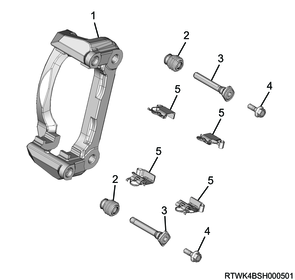
Legend
- Support bracket
- Boot
- Guide pin
- Lock bolt
- Pad clip
9) Inspect the ring seal for the following.
- Wear
- Damage
- Other malfunctions
10) Inspect the dust boot for the following.
- Wear
- Damage
- Other malfunctions
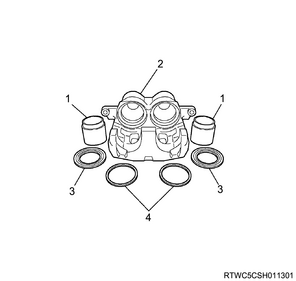
Legend
- Piston
- Caliper body
- Dust boot
- Ring seal
2. Disc brake pad inspection
1) Measure the thickness of the disc brake pad.
Standard: 10.0 mm { 0.394 in }
Limit: 1.5 mm { 0.059 in }
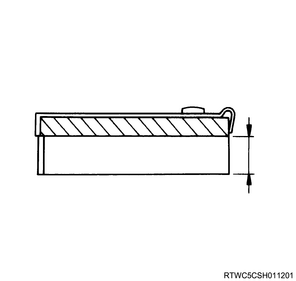
Note
- When the pad wear indicator makes a scratching sound or is worn to within 1.8 mm {0.071 in} of the shoe table, replace the pad.
Caution
- If replacing the disc brake pad, replace all 4 pads.
3. Brake rotor inspection
1. Visual inspection
1) Inspect for the following.
- Wear
- Bending
- Deterioration
- Corrosion
- Scratches
- Other malfunctions
2. Thickness measurement
1) Measure the thickness of the brake rotor.
| Specifications |
Standard value |
Limit |
| 2WD (Except high ride suspension specifications) |
30.0 mm { 1.181 in } |
28.0 mm { 1.102 in } |
| 2WD (High ride suspension specifications), 4WD |
30.0 mm { 1.181 in } |
28.0 mm { 1.102 in } |
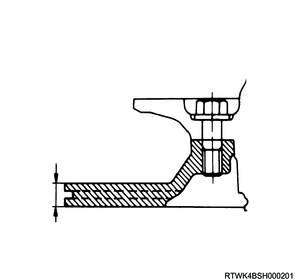
3. Parallelism measurement
1) Measure the degree of parallelization of the brake rotor.
Note
- Measure at a position located 10 mm {0.04 in} inward of the brake rotor outer edge within 0.023 mm {0.0009 in} of the contact surface.
- Measure at 8 or more locations in the circumferential direction.
Limit: 0.023 mm { 0.00091 in }
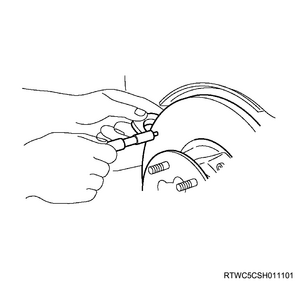
4. Brake rotor vehicle inspection
1. Runout measurement
Correctly adjust the front hub preload before measuring.
1) Measure the runout using a dial gauge.
Note
- Measure at a position of 20 mm {0.79 in} from the brake rotor outer edge of the surface that makes contact with the disc brake pad.
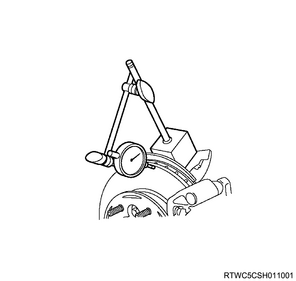
Limit: 0.050 mm { 0.00197 in }